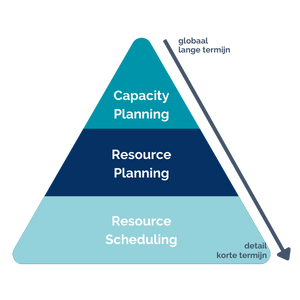What is Strategic Resource Management?
And why would you want to introduce it to your organization?
Strategic Resource Management is the process of utilizing the available human resource capacity in the best way both for long and short term in order to successfully achieve the stategic change objectives.
The nature of those objectives differ per type of organization and can be quantative and qualitative. E.g. increasing market share, decreasing the carbon footprint or introducing a new market proposition.
Three core processes of Strategic Resource Management
Strategic Resource Management consists of three core processes with varying planning horizons: Capacity Planning, Resource Planning, and Resource Scheduling. All three processes are continuously executed.

1. Capacity planning
This is the most high-over process and addresses the long term. During Capacity Planning you make a general estimation of the skills or teams you need for every initiative in the change portfolio. You offset those against the available capacity of skills or teams. The planning horizon is approximately three years. By doing this in advance, you create early insight into the feasibility of change. It also creates clarity on the need for capacity adjustments. Those adjustments can take many forms: prioritizing, increasing the capacity with either temporary or permanent manpower, training people, etc.
2. Resource Planning
This level covers the mid-term. This is usually about a frull calendar year. You compare the generic view from the Capacity Planning to a more detailed outline of the running projects. This can lead to a planning adjustment. At this stage you also determine how much capacity you want to asign to every project. You identify possible over-allocation of skills or teams. You solve that over-allocation by moving projects in time, increasing the capacity temporarily, or adjust the expectations on the completion of projects.
3. Resource Scheduling
Resource scheduling addresses the short term, approximately three months. It is a highly detailed planning. Based on the ‘Resource Planning’ you allocate specific employees to projects. In this stage, you not only plan, but also compare the planned hours with the time actually spent.
The advantages of Strategic Resource Management
Strategic Resource Management offers many advantages for organizations. The three most important ones are:
- Improved productivity. There is better insight into the feasibility of the portfolio planning. This prevents overloading employees and that in turn improves productivity.
- Projects are completed faster. By focussing the use of capacity you prevent fragmantation as a result of too many projects. This shortens the run time of your projects.
- Improved decision making. With Strategic Resource Management you can identify bottlenecks and capacity challenges at an early stage. Thus leaving you time to solve them more adequately and come to better decisions.
Organizations that manage their capacity successfully, can respond better to new opportunities and challenges.
Want to know more about Strategic resource management? In our free webinar we explain more about the thought behind Strategic Resource Management. And of course, we show you how the Fortes Change cloud provides in functionality to support it. Sign up for this (Dutch) webinar using the form below.